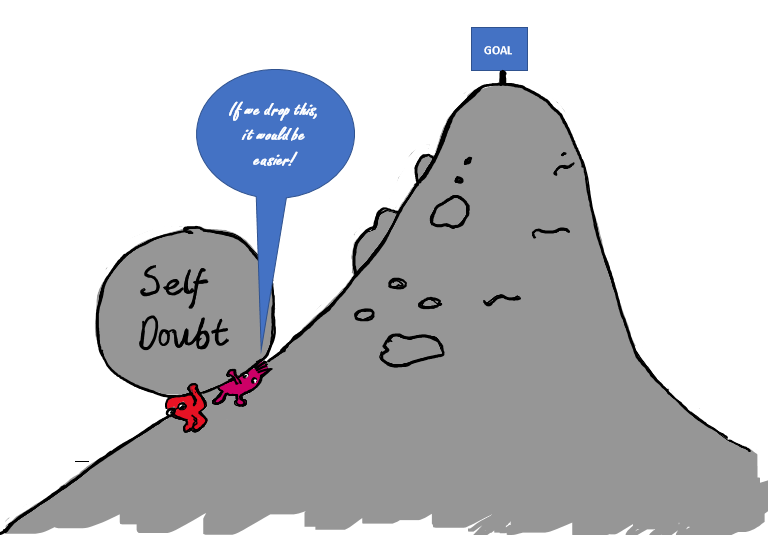Facing your fears
Many people who suffer from anxiety, depression or low self-esteem tend to make negative predictions about how certain situations will turn out. You may tend to:
- Overestimate the likelihood that bad things will happen or that something will go wrong
- Exaggerate how bad things will be
- Underestimate your ability to deal with things if they don’t go well
- Ignore other factors in the situation which suggest that things will not be as bad as you are predicting
When you jump to such negative conclusions about the future, you will develop unhelpful behaviours. You may tend to:
-Avoid the situation totally
-Try the situation out but escape when things seem too difficult
-Be overly cautious and engage in safety behaviours

The problem with these strategies is that they prevent you from actually testing your ideas. This makes it very hard for you to ever have a different and (often better) experience from what you imagine, so you continue to expect the worst. Over time those fears can get even stronger. The following is designed to help you combat those fears and break the cycle.
Gently Does It…
Some people might encourage you to tackle your biggest fear first – to “jump in the deep end” and get it over and done with. However, many people prefer to take it “step by-step”, what some people call “graded exposure”. By using graded exposure you start with situations that are easier for you to handle, then work your way up to more challenging tasks. This allows you to build your confidence slowly, to use other skills you have learned and to get used to things. By doing this in a structured and repeated way, you have a good chance of reducing your anxiety.
Rate Your Fear

The first thing to do is to think about the situations that you fear and try to avoid. For example, some people might hate going to social places, or being assertive with others. Make a list of these circumstances.
Then indicate how much distress you feel in those situations by giving them each a rating on a scale of 0 to 100.
0 – You are perfectly relaxed
25-49 – Mild: You can still cope.
50-64 – Moderate: You are reasonably distracted by the anxiety,
65-84 – High: Difficult to concentrate, thinking of escape
85-100 – Extreme: The anxiety is overwhelming –
PANIC and ESCAPE!
Plan Your Goals
Next, if you weren’t anxious, what would you like to achieve?
For instance, a situation that you avoid might be “Going to pubs“, which has a distress rating of 75. A goal for this might be “To go out to a pub on a weekend night with friends and stay there for at least 2 hours”.
When you are developing a goal, it needs to be as clear i.e. “to eat lunch in a local restaurant on my own” is better than a vague “to eat in public“. It also needs to be realistic and achievable within a specific time frame. This gives you focus and stops you running before you can walk!
Next, you need to break the goal down into reasonable stages. Obviously high stress situations will need more steps to reach your objective. You could change WHO is there, WHAT you do, WHEN, WHERE and HOW long you do it for, and build up slowly.
Recovery Road
Here are a few tips:
Before
- Coping with anxiety. Anticipate, identify and practice ways of managing any distress in advance. For instance, breathing exercises can help to reduce the physical response to anxiety, as do muscle relaxation techniques.
- Put your attitude on trial. Another way to prepare is to challenge those negative thoughts that you have about yourself or the circumstances. Working through those beliefs can provide helpful alternative ways of thinking.

During
- Expect some anxiety. Remember that you will probably experience some discomfort at all the stages of the process. That’s why its important to start small and work your way up.
- Use your skills. Just as you used your coping skills to prepare, use them in the situation. Use your breathing methods when needed and monitor your thoughts. If necessary, argue with your pesky inner voice!
- Stay- don’t run. While it might be tempting to leave if you feel uncomfortable, try to wait until you anxiety diminishes. It proves that, as frightening as the feelings are, they are not dangerous, and they do subside.
- Stay involved. Avoidance can happen in many different ways, such as sitting away from others, or dodging eye contact. Being fully present and experiencing is the only way to take real control of your anxiety.
- Stay sober. Staying involved means not taking alcohol or drugs to try to ‘mentally escape’. Sorry…
Climbing
- Don’t run before you can walk. Remember it is not about taking giant leaps, it’s about taking one small step at a time. Begin with the least difficult task and gradually work you way up, getting used to the anxiety you fell at each stage. Your primary aim is to complete that stage and that stage alone.
- Over and over again. Do a step as frequently and in close succession as you need to make sure you are comfortable before moving on. This might take 3 or 4 times.
- Use your skills. Work through any unhelpful thoughts about the situation after you have completed, or repeat the step.
- Acknowledge the steps you’ve made. Celebrate each stage of success by ‘rewarding’ yourself and don’t allow that mean inner critic to belittle it!
- Setbacks. We all have our up and down days, and sometimes you get demoralised if an exercise didn’t go as well as you hoped. It would be useful to repeat the step again or design an ‘in between’ stage.
- Use a diary. It can help you keep track of the steps you’ve completed, the expected and actual level of distress experienced, and how you can cope with any difficulties you’ve had.
If you’re having difficulties with such tasks, or think you would like some extra support, talk to one of the college counsellors
For example, let us pretend you have been invited to a party by ‘Abby’. Your usual response may be to either avoid it altogether; attend but to leave as soon as you feel uncomfortable; or to stand in the corner and only speak to one person you already know. This may help you reduce your discomfort in the short term, but it you will continue to have these thoughts and your anxiety will persist.
What could have been an alternative way to handle the party situation described above? A different approach could be to go and try your best to have a nice time and speak to others. (Easier said than done – we know!) Later on you could compare your original gloomy thoughts against your actual experience.
Think of yourself as a scientist, putting your beliefs under the microscope.
Behavioural ‘tests’ can help you to develop more realistic and/or balanced predictions. It is best to start simply and increase the challenge step-by-step.
- Firstly, what is your negative thought or belief? Then rate how strongly you believe it could happen from 0-100.
- e.g. I will have a terrible time at the party. Even if I try no-one will talk to me. (90)
- What is an alternative way to think about it? Rate how strongly you believe this alternative (0-100)
- e.g. I will find at least one person to talk to and it will be ok (10)
- Plan how to test your prediction – when will you do it, how long will it take, and with whom? Try to be as specific as possible.
- e.g. I’ll go to the party at 8pm with a mate, and I will stay for at least one hour. I will try to chat with at least three people, one that I did not know already. I won’t get drunk or wear my headphones.
- Identify likely problems and how to deal with them.
- e.g. There might not be anyone I know going to the party. But I know the host. I might offer to help set up and hang with her until I feel more confident.
- Carry out your plan. Remember to take notice of your thoughts, feelings, and behaviours.
- Write down what happened, what did you observe?
- Consider the evidence for and against your original prediction.
- What did this say about your negative prediction? e.g. I felt terrified at first but I used my breathing exercise to calm myself. Abby seemed happy to talk to me, and I also spoke to Kathryn, who I hadn’t seen in ages. She introduced me to her boyfriend Alex and we had a good chat about uni. At one point I worried I had said something stupid, but Alex didn’t seem to notice, so my worry passed.
- What have you learned? e.g. I am capable of making conversation and enjoying myself in a casual social situation.
- Rate how strongly you now believe in your original prediction and the alternative from 0-100. e.g. I will have a terrible time at the party. Even if I try to talk to people, no-one will talk to me. (10) e.g. I will find at least one person to talk to and it will be ok. (80)
For example: your goal was to go out to the pub on a weekend night and stay there for two hours. Your distress rating was evaluated at 80. This could be how you might achieve it in stages.
| Steps | Distress 0-100 | |
| 1 | Go to the local pub on a weekday afternoon (with a friend who knows about the problem), buy a soft drink and stay for 10min | 35 |
| 2 | Go to the local pub on a weekday afternoon (with a friend who knows about the problem), buy a soft drink and stay for 30min | 45 |
| 3 | Go to the local pub on a weeknight (with a friend who knows about the problem), staying from 7pm to 8pm | 55 |
| 4 | Go to the local pub on a weekend night (with a friend who knows about the problem), and stay for 30 minutes | 65 |
| 5 | Go to the local pub on a weekday night (with a friend who knows about the problem), staying from 8pm to 10pm | 70 |
| 6 | Go to the local pub on a weekend night (some of the friends don’t know about the problem), staying from 8pm to 10pm | 80 |